
Info Sheet 69: Formulation in Risk Practice 2
Following on from Information Sheet 68 this information sheet provides practical suggestions about how to use formulation with children and their parents/carers.

Info Sheet 70: Criminal Justice (Scotland) Act 2016
This information sheet brings you information regarding the Criminal Justice (Scotland) Act 2016 and implemented changes regarding arrest for criminal offences for young people.

Info Sheet 68: Formulation in Risk Practice
This information sheet looks at formulation in risk practice, focusing on the formulation stage of the Framework for Risk Assessment Management Evaluation (FRAME) as formulation

Information Sheet 68 References
Reference Sheet to accompany information sheet 68 Formulation in Risk Practice

Info Sheet 67: Understanding the relationship between brain development and offending behaviour
The brain is the most complex organ in the human body and is responsible for controlling all of the body’s functions. A number of factors

Info Sheet 65: Health provision for young people aged under 18 in and leaving SPS custody
It is widely recognised that there is a cyclical link between inequality, offending, being a victim and poor health. However, a period of detention in

Info Sheet 64: Restorative Justice – What Scotland can learn from Northern Ireland
Evidence shows that Restorative Justice (RJ) can have a useful impact on reducing reoffending while giving victims a sense of having their voices heard within

Info Sheet 62: Arts Interventions with Young People
This Information Sheet, written by Elaine Vallance, looks at the use of arts based interventions with young people involved in or at risk of offending

Info Sheet 61: Practitioner Research
With the focus on evidence-informed practice and accountability, generating more practitioner research is seen as an important way to increase the quality and quantity of

